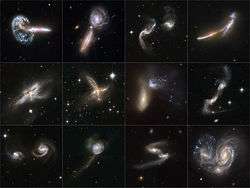NGC 34
| NGC 34 | |
|---|---|
|
NGC 34 Hubble Space Telescope | |
| Observation data (J2000 epoch) | |
| Constellation | Cetus |
| Right ascension | 00h 11m 06.5s[1] |
| Declination | −12° 06′ 26″[1] |
| Redshift | 0.019617[1] |
| Helio radial velocity | 5,881 ± 2 km/s[1] |
| Apparent magnitude (V) | 15.3[1] |
| Characteristics | |
| Type | Sc[1] |
| Apparent size (V) | 2′.2 × 0′.8[1] |
| Other designations | |
| NGC 17,[1] PGC 781[1] | |
NGC 34 is a spiral galaxy in the constellation Cetus.
NGC 34 is the result of a merger between two disk galaxies, resulting in a recent starburst in the central regions and continuing starforming activity. The galaxy is still gas-rich, and has a single galactic nucleus. It lies 250 million light years away.


Due to the major merger event NGC 34 has no defined spiral arms like the Milky Way galaxy. Unlike the Milky Way, the center bar nucleus is also distorted.[2] The merger destroyed any galactic habitable zone that may have been there before the merger.[3] [4] For the Milky Way, the galactic habitable zone is commonly believed to be an annulus with an outer radius of about 10 kiloparsecs and an inner radius close to the Galactic Center, both of which lack hard boundaries.[3]
References
- 1 2 3 4 5 6 7 8 9 "NASA/IPAC Extragalactic Database". Results for NGC 17. Retrieved 2006-12-07.
- ↑ Futurism, futurism.com, Astronomy Photo of the Day: 10/2/15 — NGC 34
- 1 2 Gowanlock, M. G.; Patton, D. R.; McConnell, S. M. (2011). "A Model of Habitability Within the Milky Way Galaxy". Astrobiology. 11 (9): 855–873. arXiv:1107.1286
 . Bibcode:2011AsBio..11..855G. doi:10.1089/ast.2010.0555. PMID 22059554.
. Bibcode:2011AsBio..11..855G. doi:10.1089/ast.2010.0555. PMID 22059554. - ↑ Choi, Charles Q. (21 August 2015). "Giant Galaxies May Be Better Cradles for Habitable Planets". Space.com. Retrieved 24 August 2015.
Coordinates: ![]() 00h 11m 06.5s, −12° 06′ 26″
00h 11m 06.5s, −12° 06′ 26″
.jpg)